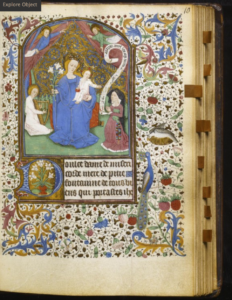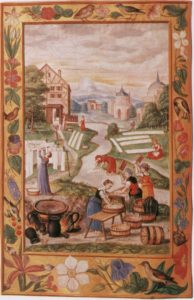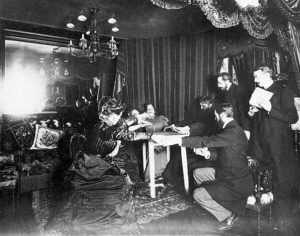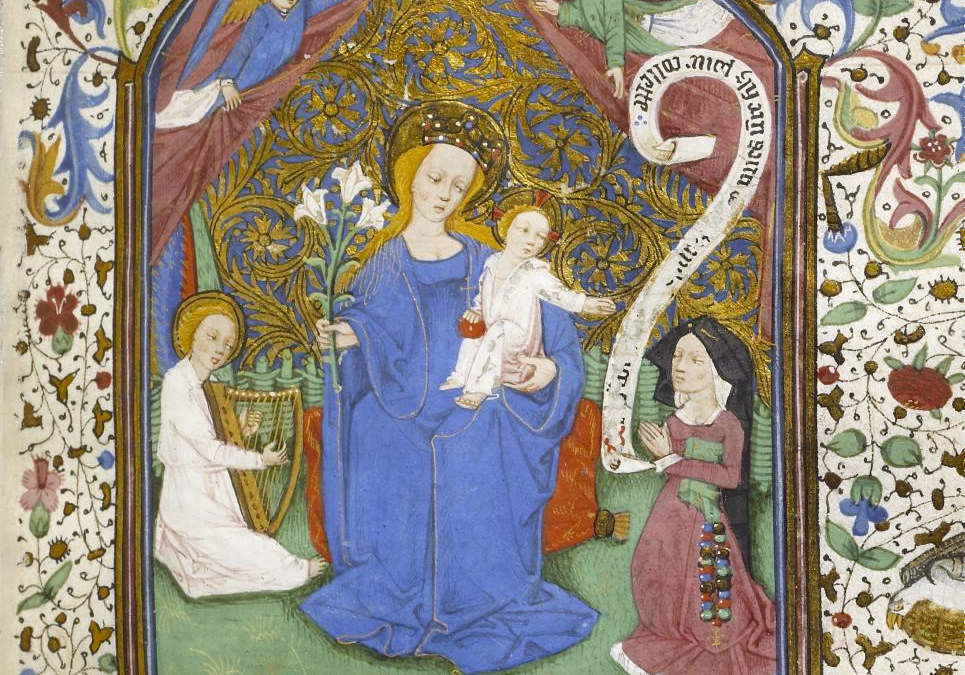As Christmas approaches, we thought we’d provide you with some yuletide reading as you sit by the fireside with a mince pie or two. Once again we have collated a top ten of our favourite, most interesting, most surprising articles that we index at the BBIH.

Example of miniature in a Book of Hours (Walters Art Gallery, W.269.76R)
1. Chronologically, our first entry is ‘A Gift, a Mirror, a Memorial : The Psalter-Hours of Mary de Bohun’, a book chapter by Jill Havens in Medieval women and their objects. The Psalter-Hours (Oxford, Bodleian Library MS Auct. D. 4. 4) is a beautiful fourteenth-century manuscript commissioned for Mary de Bohen (c. 1368-1394) by her mother Joan Fitzalan for her marriage to Henry IV (then Bolingbroke). This manuscript was intended for personal devotion, and is small enough to be easily portable. This book chapter analyses a full-page miniature of the Virgin Mary with Christ on her lap (fol. 181), which also features a young aristocratic woman in the bottom left-hand corner, representing Mary de Bohun. Although donor portraits were not unusual, there is an intimacy between the figures in this miniature that is rare, as they all inhabit the same sacred space. Havens explores the relationship between Mary de Bohun and her mother Joan Fitzalan, and what this manuscript would have represented to them individually. It is a fascinating glimpse into female book ownership and familial bonds in the fourteenth century.

Splendor Solis 1532-35; women washing clothes
2. Moving on to the early modern period, we have the book chapter ‘In praise of clean linen: laundering humours on the early modern stage’ by Natasha Korda and Eleanor Lowe in The Routledge handbook of material culture in early modern Europe. This addresses the issue of changing attitudes towards hygiene, moving away from the sixteenth century trend from immersing the whole body in water, to an emphasis on clean clothes to achieve cleanliness. Drawing on the shifts in cultural norms, when use of communal bathhouses declined due to fears of contagion, this chapter looks at clean linens on the Shakespearean stage, considering the use of ruffs, handkerchiefs, smocks and tablecloths.
3. Going further afield, we have ‘Slavery and inter-imperial leprosy discourse in the Atlantic World‘ an article by Kristen Block in the journal, Atlantic Studies. This article draws attention to the reappearance of leprosy in the colonial world, despite its decline during the early modern period. Following the European discourse in the seventeenth and eighteenth century, Block unpicks the anxiety about the links between leprosy and sin, slavery and colonialism, and charts the consensus of racialized medical opinions, aided by the growth of printed publications. Unfounded scientific theories, together with colonial reports from English, Dutch and French plantations, meant that the cause of leprosy remained unclear until well into the nineteenth century.
4. Staying in the same region, ‘The dairymaid and the prince: race, memory, and the story of Benjamin Banneker’s Grandmother’ is an article by Sandra W. Perot in Slavery and Abolition. This tells the story of Molly Welsh Banneker, a dairymaid who was transported to Maryland c. 1683 after allegedly stealing a bucket of milk. After being indentured for seven years to a tobacco farmer, she gained her freedom and went on to became a successful tobacco farmer herself, as well as a property owner. Despite interracial marriage being outlawed, she married an African man called Bannka and they had four daughters. This article considers all the difficulties she would have faced, not only from her relationship with Bannka, but also raising her daughters alone after his death, in a complicated society that forbade interracial relations. The narrative of Molly Welsh has been handed down through oral tradition, and paints a picture of a women determined to live life her own way.
Gasparo Tagliacozzi (1545-1599) illustration of rhinoplasty
5. Next up is ‘“Off dropped the sympathetic snout”: shame, sympathy, and plastic surgery at the beginning of the long eighteenth century’, a book chapter by Emily Cock in Passions, sympathy and print culture: Public opinion and emotional authenticity in eighteenth-century Britain. This looks at the relationship between medical sympathy and moral sentiment, as the medical procedure for grafting skin onto noses damaged by syphilis came under fire, as the transgressor, looking healthy, could then escape the moral judgement from the public. The significance of the nose is explored, and how medical rhinoplasty came to be satirised in poetry, resulting in a shaming of the procedure which ultimately silenced skin graft technology in the early modern period.
6. ‘From the Andes to the Outback: Acclimatising alpacas in the British Empire’ is an article by Helen Cowie in The Journal of Imperial and Commonwealth History, charting the introduction of the first alpaca in Britain in 1811 and subsequent attempts to naturalise the animal to reap the benefits for textile manufacture. They were often smuggled out of Peru, and introduced to areas such as the Scottish Highlands and Australia. This article explores the implications of this unsuccessful attempt on naturalisation as an imperialistic act, and brings to the fore the internal politics of Britain, Australia, Peru and Bolivia within the textile and agricultural industry.

Image from Wikipedia
7. Onto more supernatural things now, with ‘“Freaks of furniture”: The useless energy of haunted things’ by Aviva Briefel in the journal Victorian Studies. The craze for séances had reached England from America in the 1850s, and table-turning and rapping had become a standard feature of communicating with the dead. The animation of manufactured objects caused concern among Victorian households, raising anxieties over the production of these items, made by anonymous craftsmen or factory workers. Reports of animated objects also led to discussions on productive labour and ‘the line between efficient and wasted energy’.
8. Back to reality for this next article – ‘Criminal careers of female prisoners in Australia, 1860–1920’ by Alana Jayne Piper and Victoria Nagy in the Journal of Interdisciplinary History. Examining the criminal records of over six thousand women, the authors have identified flaws in using specific offense categories. In the Victorian system, criminal offenses committed by women generally fell into three groups – property, personal and public-order, and historians have largely examined these categories in isolation to each other, overlooking how some women were involved in multiple forms of offending. By looking at the overlap, greater insight can be shed into the complex criminal sub-cultures that women were involved in.
9. Into the twentieth century now, with ‘An “Insult to soldiers’ wives and mothers”: The Woman’s Dreadnought‘s campaign against surveillance on the home front, 1914–1915’ by Stephanie J. Brown in The Journal of Modern Periodical Studies. The Woman’s Dreadnought was an East London newspaper led by Sylvia Pankhurst, and in 1914-15 it exposed a surveillance operation by the Metropolitan Police that targeted the wives of soldiers and sailors on active duty. By finding evidence of ‘bad behaviour’ while their husbands were absent, the operation aimed to allow the government to suspend the women’s separation allowance. This article highlights Pankhurst’s campaign to uncover these covert tactics and to raise greater awareness of how surveillance made women more vulnerable, particularly to blackmail.
10. And finally, as a contrast to the dark, miserable winter days, we have ‘Beside the seaside. The archaeology of the twentieth-century English seaside holiday experience: A phenomenological context’ by Niall Finneran in the International Journal of Historical Archaeology. Tapping into the affectionate regard that English people hold for seaside resorts, this article examines the experience of the resort holiday in terms of place, space and materiality. Finneran considers the rise of the holiday resort from the Victorian period until its decline in the 1960s, due to the popularity of the package holiday. Looking particularly at Teignmouth in Devon, he discusses the whole holiday experience, from the journey there, to the accommodation and the activities available.

And on that note, the BBIH would like to wish you a merry Christmas and a happy new year!

